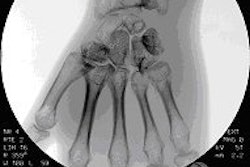Today's digital imaging industry has come far for hospitals. The basic technology is ready, and hospitals are now acquiring, viewing, and storing more and more of their images digitally. The problem is that all of this is still only happening inside the radiology department.
What's needed now for digital imaging to realize its full potential -- both in cost savings and in improved patient care -- is a supporting infrastructure of hardware, software, and service options that extends image viewing outside of the radiology department into the rest of the hospital.
In fact, two critical components for widespread image distribution are:
- The availability of viewing hardware (especially DICOM-calibrated displays), with its cost and features tailored to each user environment
- The ability for hospitals to manage this distributed hardware, and provide quality assurance from one centralized location
Digital photography and digital medical imaging: A tale of two industries
In the 1990s, when digital camera prices finally dropped out of the stratosphere and came within easy reach of the mass market, people still looked cross-eyed at the new technology. Sure they saw the advantages and the potential, but the practicalities were still missing: "How can we share our pictures with all our friends without mailing them the camera?" and "What can we use to show our digital pictures to everyone?" Just getting the JPEGs out of the camera and onto the desktop seemed like way too much work.
Today those digital doomsayers are snapping cell phone pictures at the beach and sending them to friends back home. They're sending photos to personalized Web sites, televisions, and digital picture frames. They're using online photo services like Ofoto.com, and printing paper versions on their home printers.
What finally tipped the digital photography market over into widespread use?
Not camera price alone. What was absolutely vital was the development of new products that made it easy to view and share digital photos from many different locations.
The problem that the digital photography market faced in the 1990s is exactly what the medical digital imaging industry faces today:
Hospitals have deployed digital imaging solutions inside their radiology rooms, and have made wide-scale investments to acquire, store, and view these images inside of radiology.
Now for digital imaging to really take off, hospitals need effective methods for extending image viewing outside of the radiology department so images can be shared by the entire hospital.
Without the ability to extend digital images, hospitals need to maintain a digital imaging infrastructure in the radiology department and a film infrastructure for the rest of the hospital, resulting in twice the expense.
Everyone agrees that digital imaging offers a huge advantage in terms of cost-effective delivery of services and improved patient care. What's needed now for digital imaging to realize its full potential is what the digital photography industry eventually achieved: effective ways to view the images in a variety of locations. We need the products and services that will make digital images easy to share and view across the entire hospital.
Hospital PACS: Full digital distribution = full benefits
If you limit your digital imaging to the radiology room, you also limit your potential for cost savings and better patient care. That is, while the cost-effective digital system is in the radiology department, hospitals still need their old film-based systems to view the images outside of radiology. So the hospital will have to maintain the cost structure of the digital system, as well as the film system. That is at least twice as expensive as any one system.
Picture fully distributed digital imaging in the following scenario in which a patient, Bob, arrives at the ER with severely fractured ribs:
ER sends Bob to radiology for chest x-rays. The studies are added to the hospital PACS/RIS database.
In the radiology room, a radiologist calls up the shots and makes a diagnosis from a diagnostic review workstation.
Back in the ER, physicians and nurses access Bob's x-rays and the radiologist's diagnosis on a referral review workstation to assess urgency and treatment options.
Bob is sent to the OR, where the surgical team accesses his studies on a surgical review cart.
In postop and ICU, those same x-rays, plus new ones, are accessed on a clinical workstation at the nursing station as the case is reviewed during shift rotation.
Bob's general practitioner is notified and accesses the studies from the PACS on her home computer, which is equipped with a clinical review display. While reviewing it, she notices an unusual density in an undamaged area of the lung, and requests that it be reviewed by a radiologist.
The radiologist accesses the x-rays again on a diagnostic review workstation, and determines whether malignancy may be present.
Weeks later, the hospital's physical therapist accesses the x-rays on his clinical workstation to plan Bob's rehab treatment.
This is just one scenario. Imagine the possibilities when a hospital's digital imaging systems combine radiology, cardiology, neurology, and other specialties.
The right display for the right user
How should a hospital enable image viewing outside of the radiology room? Simply extending digital imaging using the super-high-quality displays used in radiology reading rooms would be far too prohibitive a cost. It's also completely unnecessary. A dual-head 5-megapixel (MP) grayscale monitor would be complete overkill and much too expensive for use in ERs, ORs, doctors' offices, and nursing stations.
To distribute digital imaging throughout the enterprise, hospitals need displays with performance, specifications, and costs tailored to each user's needs. They need a suite of displays such as:
Diagnostic displays: Used for radiology and mammography, in which high resolution and grayscale rendering are absolutely critical. These displays are DICOM-calibrated 2-, 3-, or 5-MP grayscale monitors, and are at the high end of the cost spectrum.
Referral displays: Designed for use in ORs, ICUs, ERs, and caregiving areas, where excellent contrast is important, but not at the level required for radiology. The displays are typically 2- or 3-MP monitors, and have DICOM calibration as well.
Clinical displays: Used in physician offices, nursing stations, and for patient-bedside education. These 1-MP desktop displays can be used for multiple purposes, but support DICOM calibration for consistency of image viewing.
Specialized displays: Solutions designed for specific medical uses, such as mobile viewing-station solutions for use in the OR.
What sets these displays apart from the consumer-grade flat-panel LCDs available in stores is their DICOM calibration. DICOM calibration ensures that the image displayed on the diagnostic display in the radiology room will look identical to the same image on the clinical display in the doctor's office. It is the necessary constant for all displays used for medical imaging.
While all of these display systems maintain the consistency of DICOM calibration and image rendering, they are also functionally and economically tailored to meet the needs of the environment in which they are working. So, a hospital can deploy a high-end $20,000 5-MP system for the radiologist reading mammograms, a $6,000 2-MP system for the oncologist reviewing the images in the OR, and a $1,000 system for the general practitioner reviewing patient files from her office.


Managing digital imaging in the new extended environment
Having cost-effective solutions for different areas of the hospital unfortunately won't be enough to cause the spread of digital imaging, as solving one problem has simply created another. That is, while flat-panel displays generally don't require the constant maintenance that CRTs do, PACS administrators or IT managers will surely require a rigorous quality assurance (QA) program to ensure DICOM calibration of their display systems.
On the other hand, display QA in the radiology room is pretty straightforward, and can be easily accomplished by manually walking around to each workstation, fully distributed digital imaging in a large hospital can potentially encompass hundreds of displays in many departments. Performing QA checks on each monitor individually would be highly inefficient and impractical, especially if the hospital has monitors in remote locations.
There's a better way. Applying common IT practices, PACS administrators and IT managers need a simple tool to monitor, manage, and control all of their digital imaging workstations from a central location.
From this centralized console or "dashboard," a PACS administrator could:
- View and adjust display parameters.
- Receive alerts of any problems by e-mail, pager, or cell phone when a display is down or out of calibration, or if its white levels have dropped out of tolerance.
- Set up alert conditions and responses.
- Access a history of DICOM conformance and other activity for each display.
This display-management console also should use a standardized protocol such as Simple Network Management Protocol (SNMP). This is the same protocol used by photocopiers and printers, so the IT department will appreciate the ease of implementation. The management console also will need a simple and intuitive graphical interface that PACS administrators can quickly and easily understand, giving them the confidence they need to keep their digital imaging displays running at peak performance.
A step toward widespread digital imaging
For digital imaging to truly succeed, hospitals are demanding access to images everywhere, and cost-effective viewing solutions are required to support this. PACS administrators need a solution to manage their viewing stations in a distributed environment without having to constantly walk around the hospital and doctors' offices day after day.
Hospitals and clinics should demand and seek vendors whose solutions will meet these criteria. These vendors will understand that cost and productivity matter, and they will not simply be providing a "one-size-fits-all" system for every part of the hospital. In concert with innovators of this sort, the industry can finally begin to realize the true potential of digital imaging.
By Matthew Harris
AuntMinnie contributing writer
December 15, 2004
Mr. Harris is vice president, corporate development at medical display provider Planar Systems of Beaverton, OR. He can be reached at [email protected], or 503-748-4671.
Copyright © 2004 AuntMinnie.com



















